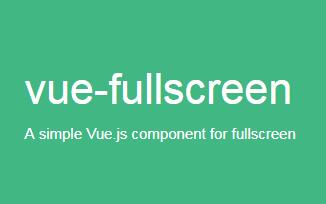vue-fullscreen
A simple Vue.js component for fullscreen.
Installation
Install from GitHub via NPM
npm install vue-fullscreen
Usage
To use vue-fullscreen, simply import it, and call Vue.use() to install.
<template>
<div id="app">
<fullscreen :fullscreen.sync="fullscreen">
Content
</fullscreen>
<button type="button" @click="toggle" >Fullscreen</button>
</div>
</template>
<script>
import fullscreen from 'vue-fullscreen'
import Vue from 'vue'
Vue.use(fullscreen)
export default {
methods: {
toggle () {
this.fullscreen = !this.fullscreen
}
},
data() {
return {
fullscreen: false
}
}
}
</script>
Caution: Because of the browser security function, you can only call these methods by a user gesture. (e.g. a click callback)
Use as plugin
In your vue component, You can use this.$fullscreen to get the instance.
<template>
<div id="app">
<div class="example">
Content
</div>
<button type="button" @click="toggle" >Fullscreen</button>
</div>
</template>
<script>
import fullscreen from 'vue-fullscreen'
import Vue from 'vue'
Vue.use(fullscreen)
export default {
methods: {
toggle () {
this.$fullscreen.toggle(this.$el.querySelector('.example'), {
wrap: false,
callback: this.fullscreenChange
})
},
fullscreenChange (fullscreen) {
this.fullscreen = fullscreen
}
},
data() {
return {
fullscreen: false
}
}
}
</script>
Methods
toggle([target, options, force])
Toggle the fullscreen mode.
- target:
- Type:
Element - Default:
document.body - The element target for fullscreen.
- Type:
- options (optional):
- Type:
Object - The fullscreen options.
- Type:
- force (optional):
- Type:
Boolean - Default:
undefined - pass
trueto force enter ,falseto exit fullscreen mode.
- Type:
enter([target, options])
enter the fullscreen mode.
- target:
- Type:
Element - Default:
document.body - The element target for fullscreen.
- Type:
- options (optional):
- Type:
Object - The fullscreen options.
- Type:
exit()
exit the fullscreen mode.
getState()
get the fullscreen state.
- Type:
Boolean
Caution: The action is asynchronous, you can not get the expected state immediately following the calling method.
Options
callback
- Type:
Function - Default:
null
It will be called when the fullscreen mode changed.
fullscreenClass
- Type:
String - Default:
fullscreen
The class will be added to target element when fullscreen mode is on.
wrap
- Type:
Boolean - Default:
true
If true, the target element will be wrapped up in a background div, and you can set the background color.
background
- Type:
String - Default:
#333
The background style of wrapper, only available when fullscreen mode is on and wrap is true.
Use as component
You can simply import the component and register it locally.
<template>
<div id="app">
<fullscreen ref="fullscreen" :fullscreen.sync="fullscreen">
Content
</fullscreen>
<button type="button" @click="toggle" >Fullscreen</button>
</div>
</template>
<script>
import Fullscreen from "vue-fullscreen/src/component.vue"
export default {
components: {Fullscreen},
methods: {
toggle () {
this.$refs['fullscreen'].toggle()
// this.fullscreen = !this.fullscreen
}
},
data() {
return {
fullscreen: false
}
}
}
</script>
Methods
toggle([force])
Toggle the fullscreen mode.You can pass force to force enter or exit fullscreen mode.
- force (optional):
- Type:
Boolean - Default:
undefined - pass
trueto force enter ,falseto exit fullscreen mode.
- Type:
enter()
enter the fullscreen mode.
exit()
exit the fullscreen mode.
getState()
get the fullscreen state.
- Type:
Boolean
Caution: The action is asynchronous, you can not get the expected state immediately following the calling method.
Props
fullscreen
- Type:
Boolean - Default:
false
Use .sync to synchronize the parent's value. You can change it to toggle fullscreen mode too.
Caution: Changing it may not work in Firefox and IE11, it may be that they handle async operation specially.
But in Firefox you can try to add babel-polyfill to the vendor in webpack like this:
module.exports = {
entry: {
app: './example/main.js',
vendor: ['babel-polyfill', 'vue']
},
...
}
Then it works, though I don't know why. ╮(╯▽╰)╭
I have no idea how to fix it in IE11 yet.
fullscreenClass
- Type:
String - Default:
fullscreen
The class will be added to the component when fullscreen mode is on.
background
- Type:
String - Default:
#333
The background style of component, only available when fullscreen mode is on.
Events
change
- isFullscreen: The current fullscreen state.
This event fires when the fullscreen mode changed.
No conflict
If you need to avoid name conflict, you can import it like this:
<template>
<div id="app">
<fs ref="fullscreen" :fullscreen.sync="fullscreen">
Content
</fs>
<div class="example">
Content
</div>
<button type="button" @click="toggle" >Fullscreen</button>
</div>
</template>
<script>
import Fullscreen from 'vue-fullscreen'
import Vue from 'vue'
Vue.use(Fullscreen, {name: 'fs'})
export default {
methods: {
toggle () {
this.$refs['fullscreen'].toggle()
this.$fs.toggle(this.$el.querySelector('.example'), {
wrap: false,
callback: this.fullscreenChange
})
},
fullscreenChange (fullscreen) {
this.fullscreen = fullscreen
}
},
data() {
return {
fullscreen: false
}
}
}
</script>



